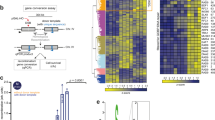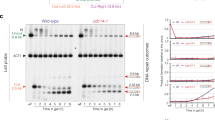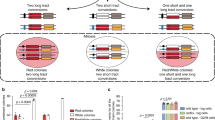Abstract
DNA recombination pathways are regulated by the cell cycle to coordinate with replication. Cyclin-dependent kinase (Cdk1) promotes efficient 5′ strand resection at DNA double-strand breaks (DSBs), the initial step of homologous recombination and damage checkpoint activation. The Mre11–Rad50–Xrs2 complex with Sae2 initiates resection, whereas two nucleases, Exo1 and Dna2, and the DNA helicase–topoisomerase complex Sgs1–Top3–Rmi1 generate longer ssDNA at DSBs. Using Saccharomyces cerevisiae, we provide evidence for Cdk1-dependent phosphorylation of the resection nuclease Dna2 at Thr4, Ser17 and Ser237 that stimulates its recruitment to DSBs, resection and subsequent Mec1-dependent phosphorylation. Poorly recruited dna2T4A S17A S237A and dna2ΔN248 mutant proteins promote resection only in the presence of Exo1, suggesting cross-talk between Dna2- and Exo1-dependent resection pathways.
This is a preview of subscription content, access via your institution
Access options
Subscribe to this journal
Receive 12 print issues and online access
$189.00 per year
only $15.75 per issue
Buy this article
- Purchase on Springer Link
- Instant access to full article PDF
Prices may be subject to local taxes which are calculated during checkout




Similar content being viewed by others
References
Malumbres, M. & Barbacid, M. Cell cycle, CDKs and cancer: a changing paradigm. Nat. Rev. Cancer 9, 153–166 (2009).
Enserink, J.M. & Kolodner, R.D. An overview of Cdk1-controlled targets and processes. Cell Div. 5, 11 (2010).
Saponaro, M. et al. Cdk1 targets Srs2 to complete synthesis-dependent strand annealing and to promote recombinational repair. PLoS Genet. 6, e1000858 (2010).
Caspari, T., Murray, J.M. & Carr, A.M. Cdc2-cyclin B kinase activity links Crb2 and Rqh1-topoisomerase III. Genes Dev. 16, 1195–1208 (2002).
Granata, M. et al. Dynamics of Rad9 chromatin binding and checkpoint function are mediated by its dimerization and are cell cycle-regulated by CDK1 activity. PLoS Genet. 6, pii: e1001047 (2010).
Diani, L. et al. Saccharomyces CDK1 phosphorylates Rad53 kinase in metaphase, influencing cellular morphogenesis. J. Biol. Chem. 284, 32627–32634 (2009).
Schleker, T., Shimada, K., Sack, R., Pike, B.L. & Gasser, S.M. Cell cycle-dependent phosphorylation of Rad53 kinase by Cdc5 and Cdc28 modulates checkpoint adaptation. Cell Cycle 9, 350–363 (2010).
Esashi, F. et al. CDK-dependent phosphorylation of BRCA2 as a regulatory mechanism for recombinational repair. Nature 434, 598–604 (2005).
Aylon, Y., Liefshitz, B. & Kupiec, M. The CDK regulates repair of double-strand breaks by homologous recombination during the cell cycle. EMBO J. 23, 4868–4875 (2004).
Ira, G. et al. DNA end resection, homologous recombination and DNA damage checkpoint activation require CDK1. Nature 431, 1011–1017 (2004).
Ferreira, M.G. & Cooper, J.P. Two modes of DNA double-strand break repair are reciprocally regulated through the fission yeast cell cycle. Genes Dev. 18, 2249–2254 (2004).
Jazayeri, A. et al. ATM- and cell cycle-dependent regulation of ATR in response to DNA double-strand breaks. Nat. Cell Biol. 8, 37–45 (2006).
Barlow, J.H., Lisby, M. & Rothstein, R. Differential regulation of the cellular response to DNA double-strand breaks in G1. Mol. Cell 30, 73–85 (2008).
Janke, R. et al. A truncated DNA-damage-signaling response is activated after DSB formation in the G1 phase of Saccharomyces cerevisiae. Nucleic Acids Res. 38, 2302–2313 (2010).
Huertas, P., Cortes-Ledesma, F., Sartori, A.A., Aguilera, A. & Jackson, S.P. CDK targets Sae2 to control DNA-end resection and homologous recombination. Nature 455, 689–692 (2008).
Huertas, P. & Jackson, S.P. Human CtIP mediates cell cycle control of DNA end resection and double strand break repair. J. Biol. Chem. 284, 9558–9565 (2009).
Yun, M.H. & Hiom, K. CtIP-BRCA1 modulates the choice of DNA double-strand-break repair pathway throughout the cell cycle. Nature 459, 460–463 (2009).
Limbo, O. et al. Ctp1 is a cell-cycle-regulated protein that functions with Mre11 complex to control double-strand break repair by homologous recombination. Mol. Cell 28, 134–146 (2007).
Bonetti, D., Martina, M., Clerici, M., Lucchini, G. & Longhese, M.P. Multiple pathways regulate 3′ overhang generation at S. cerevisiae telomeres. Mol. Cell 35, 70–81 (2009).
Clerici, M., Mantiero, D., Guerini, I., Lucchini, G. & Longhese, M.P. The Yku70-Yku80 complex contributes to regulate double-strand break processing and checkpoint activation during the cell cycle. EMBO Rep. 9, 810–818 (2008).
Zhang, Y. et al. Role of Dnl4-Lif1 in nonhomologous end-joining repair complex assembly and suppression of homologous recombination. Nat. Struct. Mol. Biol. 14, 639–646 (2007).
Zierhut, C. & Diffley, J.F. Break dosage, cell cycle stage and DNA replication influence DNA double strand break response. EMBO J. 27, 1875–1885 (2008).
Cejka, P. et al. DNA end resection by Dna2-Sgs1-RPA and its stimulation by Top3-Rmi1 and Mre11-Rad50-Xrs2. Nature 467, 112–116 (2010).
Niu, H. et al. Mechanism of the ATP-dependent DNA end-resection machinery from Saccharomyces cerevisiae. Nature 467, 108–111 (2010).
Nicolette, M.L. et al. Mre11-Rad50-Xrs2 and Sae2 promote 5′ strand resection of DNA double-strand breaks. Nat. Struct. Mol. Biol. 17, 1478–1485 (2010).
Zhu, Z., Chung, W.H., Shim, E.Y., Lee, S.E. & Ira, G. Sgs1 helicase and two nucleases dna2 and exo1 resect DNA double-strand break ends. Cell 134, 981–994 (2008).
Bishop, A.C. et al. A chemical switch for inhibitor-sensitive alleles of any protein kinase. Nature 407, 395–401 (2000).
Budd, M.E., Reis, C.C., Smith, S., Myung, K. & Campbell, J.L. Evidence suggesting that Pif1 helicase functions in DNA replication with the Dna2 helicase/nuclease and DNA polymerase delta. Mol. Cell Biol. 26, 2490–2500 (2006).
Mimitou, E.P. & Symington, L.S. Ku prevents Exo1 and Sgs1-dependent resection of DNA ends in the absence of a functional MRX complex or Sae2. EMBO J. 29, 3358–3369 (2010).
Shim, E.Y. et al. Saccharomyces cerevisiae Mre11/Rad50/Xrs2 and Ku proteins regulate association of Exo1 and Dna2 with DNA breaks. EMBO J. 29, 3370–3380 (2010).
Ubersax, J.A. et al. Targets of the cyclin-dependent kinase Cdk1. Nature 425, 859–864 (2003).
Kosugi, S., Hasebe, M., Tomita, M. & Yanagawa, H. Systematic identification of cell cycle-dependent yeast nucleocytoplasmic shuttling proteins by prediction of composite motifs. Proc. Natl. Acad. Sci. USA 106, 10171–10176 (2009).
Din, S., Brill, S.J., Fairman, M.P. & Stillman, B. Cell-cycle-regulated phosphorylation of DNA replication factor A from human and yeast cells. Genes Dev. 4, 968–977 (1990).
Mimitou, E.P. & Symington, L.S. Sae2, Exo1 and Sgs1 collaborate in DNA double-strand break processing. Nature 455, 770–774 (2008).
Gravel, S., Chapman, J.R., Magill, C. & Jackson, S.P. DNA helicases Sgs1 and BLM promote DNA double-strand break resection. Genes Dev. 22, 2767–2772 (2008).
Nimonkar, A.V. et al. BLM-DNA2-RPA-MRN and EXO1-BLM-RPA-MRN constitute two DNA end resection machineries for human DNA break repair. Genes Dev. 25, 350–362 (2011).
Hodgson, A. et al. Mre11 and Exo1 contribute to the initiation and processivity of resection at meiotic double-strand breaks made independently of Spo11. DNA Repair (Amst.) 10, 138–148 (2011).
Keelagher, R.E., Cotton, V.E., Goldman, A.S. & Borts, R.H. Separable roles for Exonuclease I in meiotic DNA double-strand break repair. DNA Repair (Amst.) 10, 126–137 (2011).
Zakharyevich, K. et al. Temporally and biochemically distinct activities of Exo1 during meiosis: double-strand break resection and resolution of double Holliday junctions. Mol. Cell 40, 1001–1015 (2010).
Giannattasio, M. et al. Exo1 competes with repair synthesis, converts NER intermediates to long ssDNA gaps, and promotes checkpoint activation. Mol. Cell 40, 50–62 (2010).
Cotta-Ramusino, C. et al. Exo1 processes stalled replication forks and counteracts fork reversal in checkpoint-defective cells. Mol. Cell 17, 153–159 (2005).
Budd, M.E. et al. A Network of Multi-Tasking Proteins at the DNA Replication Fork Preserves Genome Stability. PLoS Genet. 1, e61 (2005).
Church, G.M. & Gilbert, W. Genomic sequencing. Proc. Natl. Acad. Sci. USA 81, 1991–1995 (1984).
Ira, G., Malkova, A., Liberi, G., Foiani, M. & Haber, J.E. Srs2 and Sgs1-Top3 suppress crossovers during double-strand break repair in yeast. Cell 115, 401–411 (2003).
Sugawara, N., Wang, X. & Haber, J.E. In vivo roles of Rad52, Rad54, and Rad55 proteins in Rad51-mediated recombination. Mol. Cell 12, 209–219 (2003).
Loog, M. & Morgan, D.O. Cyclin specificity in the phosphorylation of cyclin-dependent kinase substrates. Nature 434, 104–108 (2005).
Acknowledgements
We thank N. Lyons and D. Morgan (University of California, San Francisco) for providing Cdk1 kinase and valuable advice. This work was supported by US National Institutes of Health (NIH) grants GM080600 and 3R01GM080600 to G.I., RO1GM57814 and RO1ES07061 to P.S., and GM071011 and 3R01 GM071011 to S.E.L.
Author information
Authors and Affiliations
Contributions
X.C. constructed most of the strains and plasmids, analyzed Dna2 phosphorylation in cells, carried out fluorescence microscopy and ChIP experiments. W.-H.C. and A.P. analyzed resection in mutants, and H.N. purified proteins and conducted all the in vitro experiments. Z.Z. constructed the initial plasmids carrying dna2 mutant alleles. X.C., H.N., P.S. and G.I. designed the experiments, analyzed the data and wrote the manuscript. E.Y.S. and S.E.L. did the ChIP assay for Sgs1-13 × Myc.
Corresponding authors
Ethics declarations
Competing interests
The authors declare no competing financial interests.
Supplementary information
Supplementary Text and Figures
Supplementary Figures 1–6, Supplementary Table 1 and Supplementary Methods (PDF 2358 kb)
Rights and permissions
About this article
Cite this article
Chen, X., Niu, H., Chung, WH. et al. Cell cycle regulation of DNA double-strand break end resection by Cdk1-dependent Dna2 phosphorylation. Nat Struct Mol Biol 18, 1015–1019 (2011). https://doi.org/10.1038/nsmb.2105
Received:
Accepted:
Published:
Issue Date:
DOI: https://doi.org/10.1038/nsmb.2105
This article is cited by
-
SCFSKP2 regulates APC/CCDH1-mediated degradation of CTIP to adjust DNA-end resection in G2-phase
Cell Death & Disease (2020)
-
Limiting homologous recombination at stalled replication forks is essential for cell viability: DNA2 to the rescue
Current Genetics (2020)
-
Programmable DNA repair with CRISPRa/i enhanced homology-directed repair efficiency with a single Cas9
Cell Discovery (2018)
-
Regulatory control of DNA end resection by Sae2 phosphorylation
Nature Communications (2018)
-
Pif1-family helicases cooperatively suppress widespread replication-fork arrest at tRNA genes
Nature Structural & Molecular Biology (2017)



